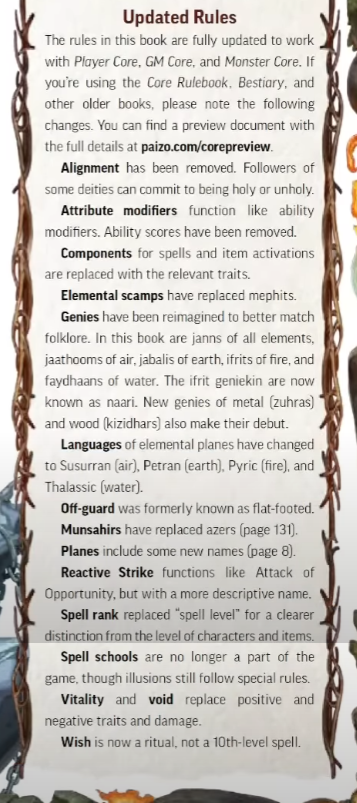These were previewed in this Roll for Combat video from two weeks ago.
Transcription:
Updated Rules
The rules in this book are fully updated to work with Player Core, GM Core, and Monster Core. If you're using the Core Rulebook, Bestiary, and other older books, please note the following changes. You can find a preview document with the full details at paizo.com/corepreview.
Alignment has been removed. Followers of some deities can commit to being holy or unholy.
Attribute modifiers function like ability modifiers. Ability scores have been removed.
Components for spells and item activations are replaced with the relevant traits.
Elemental scamps have replaced mephits.
Genies have been reimagined to better match folklore. In this book are janns of all elements, jaathooms of air, jabalis of earth, ifrits of fire, and faydhaans of water. The ifrit geniekin are now known as naari. New genies of metal (zuhras) and wood (kizidhars) also make their debut.
Languages of elemental planes have changed to Susarran (air), Petran (earth), Pyric (fire), and Thalassic (water).
Off-guard was formerly known as flat-footed.
Munsahirs have replaced azers (page 131).
Planes include some new names (page 8).
Reactive Strike functions like Attack of Opportunity, but with a more descriptive name.
Spell rank replaced "spell level" for a clearer distinction from the level of characters and items.
Spell schools are no longer a part of the game, though illusions still follow special rules.
Vitality and void replace positive and negative traits and damage.
Wish is now a ritual, not a 10th-level spell.

Yup, exactly.
In some cases they're changing the terminology purely to avoid using the OGL and move towards ORC. In some other cases it seems to be more as though they're using the opportunity of all these changes happening to make a change away from terminology they thought was unclear or not as good as they'd like.